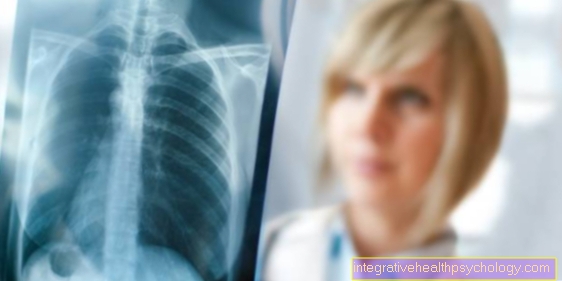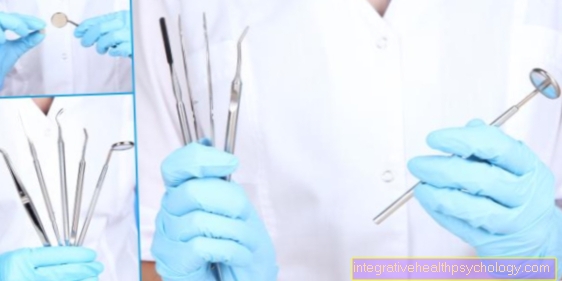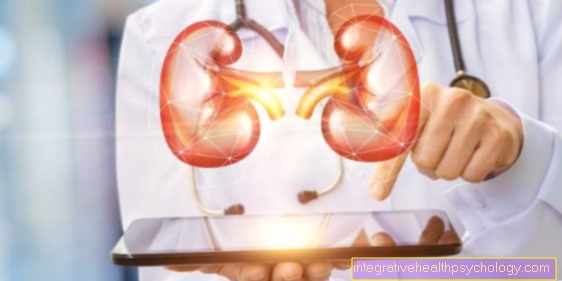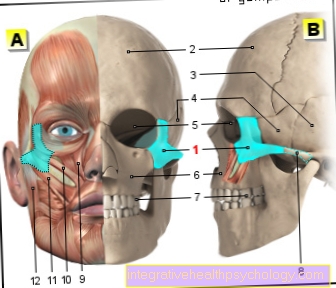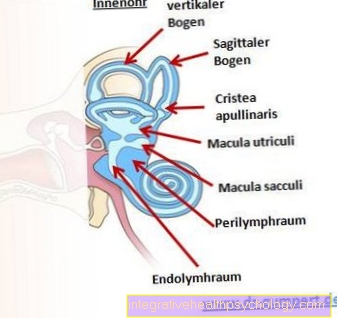This is what end-stage liver cirrhosis looks like
introduction
Liver cirrhosis is chronic and irreversible damage to liver tissue. It is a complex clinical picture that can be associated with various secondary diseases and life-threatening complications. Cirrhosis of the liver is typically based on chronic diseases such as hepatitis, fatty liver or other changes in the liver tissue. The disease can present itself very differently, depending on the stage of the liver cirrhosis and the extent of the damage so far. The onset of cirrhosis is rarely associated with symptoms, as the healthy liver tissue can adequately compensate for the important liver functions. The typical disease changes and secondary diseases only occur when a large part of the organ is cirrhotically changed.

The most important functional systems of the body, which increasingly fail with liver cirrhosis, are the filter function of toxic metabolic waste, the maintenance of blood clotting and the production of vital proteins.
The so-called “Child-Pugh classification” can be used to estimate the severity of liver cirrhosis. This includes 5 parameters for checking the coagulation function, protein production and the filter function, which can be determined on the basis of clinical examinations or blood values. Based on this classification, an individual score can be calculated, which allows a division into 3 stages of liver cirrhosis. The “Child C” stage is colloquially referred to as the “end stage”.
Learn more at: Stages of cirrhosis of the liver
Such is the course of the final stage
The exact course of advanced liver cirrhosis is difficult to predict. Since many organ systems are life-threateningly affected by cirrhosis of the liver during the course of the disease, the symptoms and complications can occur in very different parts of the body. For this reason, strict medical surveillance is required in the end-stage, as life-threatening complications can arise at any time. Typical problems that can reveal themselves in the end stage are severe infections due to a reduced immune system, but also life-threatening bleeding due to the expansion of various blood vessels in the gastrointestinal tract and reduced blood clotting. Neurological consequences can also occur due to the lack of filter function and the accumulation of toxic substances and lead to severe damage and a coma. In addition to these typical organ regions, the kidneys or lungs can also be affected by liver cirrhosis and cause serious complications, including organ failure. In the long term, cirrhosis of the liver itself increases the risk of liver cancer.
Typical symptoms of the final stage
Liver cirrhosis is a complex disease that affects various organ systems in its course and can therefore cause symptoms in all parts of the body. Typical abnormalities of liver cirrhosis include:
- Fatigue, poor performance, susceptibility to infection, feeling sick
- Sensation of pressure and fullness in the upper abdomen, loss of appetite, vomiting
- Indigestion, fatty stools, discoloration of the stool
- Itching, yellowing of the skin, rashes
- Lacquer lips, dilated blood vessels under the skin, thin and cracked skin
- Vein enlargements, for example on the abdomen, rectum, esophagus
- severe, insatiable bleeding, for example from the esophagus
- Deficiency of red and white blood cells and platelets
- Water retention all over the body, for example as ascites
- Confusion, difficulty concentrating, impaired consciousness and coma
- Hormonal disorders with breast growth, hair loss, potency or menstrual disorders
Also read our topic: Symptoms of cirrhosis of the liver
Water in the stomach
The so-called "ascites" means "Ascites“And is a very typical symptom of cirrhosis of the liver. Such water retention occurs mainly when there is increased pressure in blood vessels or when there is a lack of a certain protein in the blood (dem albumin) on. The latter means that fluid in the blood is bound less strongly and can more easily pass through the vessel walls into the surrounding tissue. In end-stage liver cirrhosis, the albumin deficiency leads to the fact that several liters of fluid can accumulate in the abdomen. The water retention in the body can lead to considerable fluctuations and disturbances in the electrolyte balance with consequential problems in the brain or heart. Therapeutically, the ascites can be punctured with a needle and drained. This should be done carefully, however, as it can lead to rapid new water retention with significant dehydration in the rest of the body. An important therapeutic measure is to increase the albumin level in the blood.
You might also be interested in this topic: Water in the stomach and Puncture water in the abdomen
Vomit
Vomiting can be caused in multiple ways in terminal cirrhosis. On the one hand, the reduced production and release of bile acid disrupts all digestive processes, which can lead to diarrhea, nausea, vomiting and a feeling of fullness in the stomach. The disturbed detoxification function of the liver can also lead to nausea and vomiting via various processes. Ammonia and bilirubin are important toxic substances that increase in the blood and cause symptoms in cirrhosis of the liver. In addition to the causes of the gastrointestinal tract, vomiting is also a common neurological symptom that is caused in certain centers in the brain. In the long term, various organs that are involved in liver cirrhosis can trigger vomiting. On the other hand, vomiting blood in the event of potential bleeding from veins of the esophagus is life threatening.
diarrhea
Diarrhea and other digestive problems are typical symptoms of advanced liver cirrhosis. The diarrhea is closely related to a drop in performance, typical fatigue, loss of appetite and the fatty stools that can occur with cirrhosis of the liver. This is mainly due to a disruption in the production of bile acids. The bile acids are produced in the liver and transported to the small intestine via the bile ducts, where they perform important digestive tasks. They are largely responsible for breaking down fats and fatty foods and binding them so that they can be digested and absorbed by the intestinal mucosa. If there is a severe loss of liver function, fatty foods can be more difficult to digest, which makes the stool bulkier, more fluid and fatty. In the long term, further secondary symptoms such as a nutritional deficiency can result.
Shortness of breath
In the case of very advanced liver cirrhosis, the lung functions can also be restricted in several ways over the long term. On the one hand, large accumulations of ascites can lead to high pressure on the lungs, and on the other hand, severe infections in the lungs can cause breathing difficulties in the end-stage. In the long term, however, liver cirrhosis can also lead to a so-called "hepatopulmonary syndrome " in which the pulmonary vessels expand and damage as a direct result of cirrhosis of the liver. High blood pressure in the pulmonary vessels causes shortness of breath and severe lung damage, which in the further course often makes a lung transplant necessary.
Bleeding
Bleeding is one of the greatest risks and a frequent cause of death in severe cirrhosis of the liver. Due to the increased pressure in numerous blood vessels in the gastrointestinal tract, so-called "bypass circuits" from intestinal sections to the heart, bypassing the liver, form in the course of the disease. This leads to dangerous enlargements of numerous veins, which can be seen, for example, along the navel or which are dangerous veins in the esophagus (Varices) represent. Due to the severely restricted blood clotting, heavy and insatiable bleeding can occur. Cirrhosis of the liver can lead to significant deficiencies in the coagulation factors produced by the liver. However, the blood platelets, which play an essential role in blood clotting, are also reduced as an indirect consequence of liver cirrhosis. If bleeding occurs from the so-called "esophageal varices" or other vessels in the body, the body is often not able to breastfeed them on its own. Surgical interventions to stop bleeding are often necessary.
You might also be interested in the following topic: Esophageal variceal bleeding
confusion
A confusion in the context of liver cirrhosis is due to a so-called "Hepatic encephalopathy" attributed to a functional impairment of the brain. Encephalopathy is caused by toxic substances such as ammonia or bilirubin, which accumulate in the blood because the liver can no longer perform its filter function. Often the filter performance of preserved liver tissue can be compensated. However, if there are increased amounts of pollutants, for example due to infections or bleeding in the intestine, the neurological symptoms can appear acute. The appearance of confusion suggests that the liver cirrhosis is in a considerably advanced stage. Furthermore, sensory and motor complaints, as well as impaired consciousness with advanced damage to the brain, can occur. A life-threatening coma represents the maximum variant of the neurological symptoms.
coma
Neurological involvement in severe liver cirrhosis is a dreaded complication and an important indicator of a very advanced stage of the disease. This is mainly due to the restriction of the filter function of toxic metabolic products. The focus is on the metabolism and excretion of ammonia, which accumulates in the body. This can accumulate in cirrhosis of the liver and lead to mood swings, tiredness, confusion, difficulty concentrating and impaired consciousness in the brain. There is also a tremor of the hands (tremor), as well as motor insecurities that can be determined, for example, in a written sample. A further increase in ammonia and other toxic metabolic products can lead to drowsiness and then to coma.
Read more on the topic: coma
Kidney failure
Renal failure is a potentially life-threatening complication of liver cirrhosis in the late stages. The exact mechanisms that lead to kidney involvement are not definitively known. However, a combination of the typical drugs that are used to detoxify cirrhosis of the liver, as well as severe water loss, water retention or acute bleeding can promote a reaction in the kidney. This leads to kidney failure due to insufficient blood flow. This results in a reduced excretion rate of the kidneys with life-threatening fluctuations in the body's electrolyte balance.
Also read our topic: Renal failure
Liver transplant
As cirrhosis of the liver is a permanent and life-threatening disease, liver transplantation is the only treatment option for cirrhosis and restoration of liver function. Liver transplantation is a rare and high-risk surgical procedure that involves the transplantation of a whole or part of a liver from a deceased or living donor. Since a healthy liver is sufficiently large, only parts of the liver can be transplanted or, in a healthy donor, parts of the liver can be removed without consequences. However, the selection of the recipients is time-consuming and takes place according to various strict criteria. The severity of the disease is determined using the so-called "MELD score". However, other criteria such as age, the prospect of an improvement in vital function or abstinence from alcohol also play important roles.
You may also be interested in this topic: Liver transplantation
So life expectancy is in its final stages
Cirrhosis of the liver is a permanent disease that cannot be reversed even by treatment of the causes such as treatment of hepatitis or alcohol abstinence. The prognosis depends entirely on the remaining function of the liver in order to maintain the vital filter functions or blood clotting. Liver transplantation is the only possible treatment option besides symptomatic diagnosis and treatment of secondary diseases. However, due to the involvement of the many organ systems in advanced liver cirrhosis, the risk of severe infections or bleeding increases so much in the end stage that the overall prognosis is very reduced despite medical supervision and early therapy. For stage “Child C”, an overall 1-year survival probability of 35% can be assumed.
You might also be interested in this topic: What is the life expectancy with liver cirrhosis?





